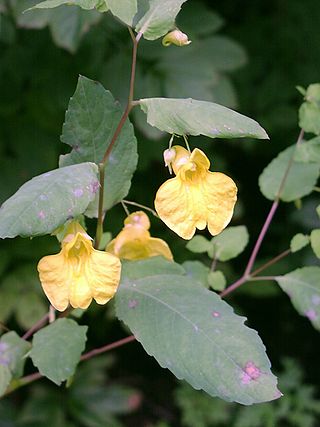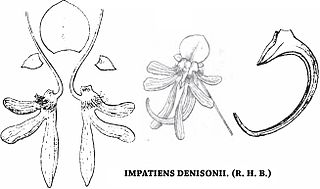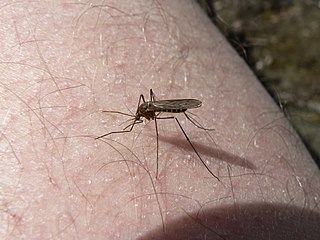
Impatiens is a genus of more than 1,000 species of flowering plants, widely distributed throughout the Northern Hemisphere and the tropics. Together with the genus Hydrocera, Impatiens make up the family Balsaminaceae.

Impatiens walleriana, also known as busy Lizzie, balsam, sultana, or simply impatiens, is a species of the genus Impatiens, native to eastern Africa from Kenya to Mozambique. The Latin specific epithet walleriana honours a British missionary, Horace Waller (1833–1896).

Impatiens glandulifera, Himalayan balsam, is a large annual plant native to the Himalayas. Via human introduction it is now present across much of the Northern Hemisphere and is considered an invasive species in many areas. Uprooting or cutting the plants is an effective means of control.

The Balsaminaceae are a family of dicotyledonous plants, comprising two genera: Impatiens, which consists of over 1000 species, and Hydrocera, consisting of 1 species. The flowering plants may be annual or perennial. They are found throughout temperate and tropical regions, primarily in Asia and Africa, but also North America and Europe.

Impatiens capensis, the orange jewelweed, common jewelweed, spotted jewelweed, jewelweed, spotted touch-me-not, or orange balsam, is an annual plant in the family Balsaminaceae that is native to North America. It is common in bottomland soils, ditches, and along creeks, often growing side by side with its less common relative, yellow jewelweed.

Impatiens noli-tangere is an annual herbaceous plant in the family Balsaminaceae found in damp places in Europe, Asia and North America. The yellow flowers are followed by pods which forcefully explode when ripe, ejecting the seeds for some distance.

Impatiens balsamina, commonly known as balsam, garden balsam, rose balsam, touch-me-not or spotted snapweed, is a species of plant native to India and Myanmar.

Impatiens denisonii is a scapigerous herb species of the family Balsaminaceae, which is found only in the Western Ghats in South India. It is among the rarest of the eighteen Impatiens species which are endemic to the Nilgiri Hills. It was very abundant and considered among the most beautiful plants in the Nilgiri Hills.

Impatiens flaccida is a species of flowering plant native to the Western Ghats in India and to Sri Lanka. It is an erect or decumbent herb with thin stems growing to 50 cm (20 in) in length. They root at the lower nodes. The alternate leaves are ovate-lanceolate, growing 3 to 8 cm long and 2 to 3.5 cm wide. The flowers are light purple with dark eyes, and are 3 to 4 cm wide.

Impatiens hawkeri, the New Guinea impatiens, is a species of flowering plant in the family Balsaminaceae. It is native to Papua New Guinea and the Solomon Islands. It has been bred and hybridized in cultivation to produce a line of garden plants.

Bombus impatiens, the common eastern bumble bee, is the most commonly encountered bumblebee across much of eastern North America. They can be found in the Eastern temperate forest region of the eastern United States, southern Canada, and the eastern Great Plains. Because of their great adaptability, they can live in country, suburbs, and even urban cities. This adaptability makes them a great pollinator species, leading to an increase in their commercial use by the greenhouse industry. This increase consequently led to their farther spread outside their previous distribution range. They are considered one of the most important species of pollinator bees in North America.
Mordellina is a genus of tumbling flower beetles in the family Mordellidae.
Mordellina unistrigosa is a species of beetle in the genus Mordellina. It was described in 1967.
Mordellina semiusta is a species of tumbling flower beetle in the family Mordellidae. It is found in North America.
Mordellina wickhami is a species of tumbling flower beetle in the family Mordellidae. It is found in North America.
Mordellina infima is a species of tumbling flower beetle in the family Mordellidae. It is found in North America.
Mordellina ancilla is a species of tumbling flower beetle in the family Mordellidae. It is found in North America.
Mordellina testacea is a species of tumbling flower beetle in the family Mordellidae. It is found in North America.

Culiseta impatiens is a species of mosquito in the family Culicidae.
Mordellina pustulata is a species of tumbling flower beetle in the family Mordellidae. It is found in North America.











